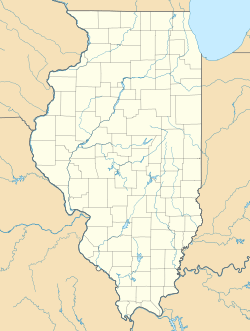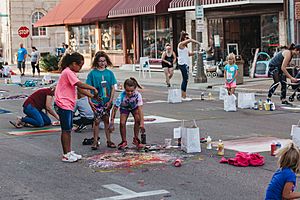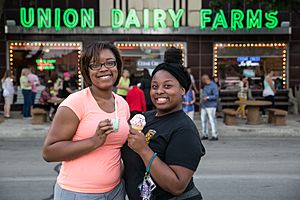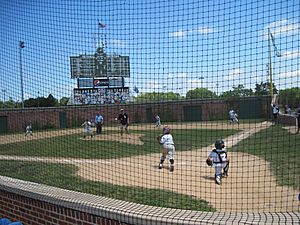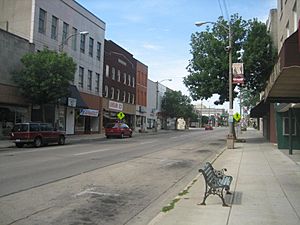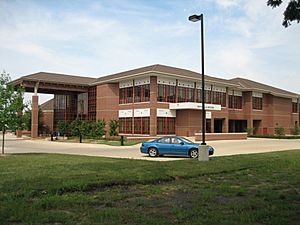Freeport, Illinois facts for kids
Quick facts for kids
Freeport, Illinois
|
|
|---|---|
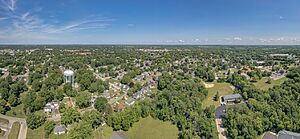
Aerial view of Freeport, IL
|
|
| Nickname(s):
Pretzel City, USA
|
|
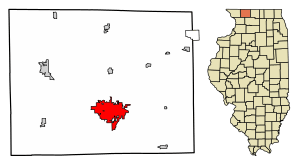
Location of Freeport in Stephenson County, Illinois.
|
|
| Country | United States |
| State | Illinois |
| County | Stephenson |
| Township | Freeport |
| Founded | 1827 |
| Incorporated | 1838 |
| Area | |
| • Total | 11.89 sq mi (30.79 km2) |
| • Land | 11.88 sq mi (30.77 km2) |
| • Water | 0.01 sq mi (0.02 km2) |
| Elevation | 778 ft (237 m) |
| Population
(2020)
|
|
| • Total | 23,973 |
| • Density | 2,017.76/sq mi (779.04/km2) |
| ZIP Codes |
61032, 61033
|
| Area code(s) | 815/779 |
| FIPS code | 17-27884 |
| Wikimedia Commons | Freeport, Illinois |
Freeport is the biggest city in Stephenson County, Illinois, USA. It is also where the county government is located. In 2020, about 23,973 people lived there. The mayor of Freeport is Jodi Miller. She was elected in 2017.
Freeport is famous for two main things. First, it hosted the second Lincoln–Douglas debate in 1858. Second, it's known as "Pretzel City, USA." This nickname comes from a German bakery that opened in 1869. It made so many pretzels that the city became known for them. The mascot for Freeport High School is even a Pretzel!
Contents
History of Freeport
Early Days and Growth
The area was first called Winneshiek. When it became an official town, it was renamed Freeport. This new name came from Tutty Baker. He ran a "free port" (a place where people could trade without fees) on the Pecatonica River. The old name, "Winneshiek," is still used by the Freeport Community Theatre Group.
In 1837, Stephenson County was created. Freeport became its main city in 1838. The town grew quickly because it was connected to Chicago by stagecoach. By 1840, Freeport had a courthouse and its first school. Within two years, there were two newspapers. By 1853, a third newspaper, printed in German, also started. At this time, about 2,000 people lived in Freeport.
The Lincoln-Douglas Debate
On August 27, 1858, a very important event happened in Freeport. It was the second debate between Abraham Lincoln and Stephen A. Douglas. These debates helped shape the future of the United States.
Even though Stephen Douglas won the election for the U.S. Senate, his answer to a question about slavery caused problems. It upset the Southern states, who called it the "Freeport Heresy." This disagreement split the Democratic Party. This split later helped Abraham Lincoln win the Presidency in 1860.
A monument to this famous debate was put up in 1903 by President Theodore Roosevelt. A life-size statue showing the event was added in 1992. Another well-known statue, Lincoln the Debater by Leonard Crunelle, is in Taylor Park. Sometimes, the debate is even re-enacted, and it has been shown on C-SPAN.
The Pretzel City Nickname
Freeport is proudly called the "Pretzel City." Its high school sports teams are called the Pretzels. This nickname reminds everyone of the city's German roots. In the late 1850s, many Germans moved to Stephenson County. They came from both Pennsylvania and Germany. They brought their love for pretzel snacks with them.
In 1869, a German immigrant named John Billerbeck opened the Billerbeck Bakery. This bakery made so many pretzels that a local newspaper called Freeport the "Pretzel City." In 2003, the city started its first Pretzel Festival to celebrate this fun nickname.
Important Buildings and Changes
Freeport is home to the oldest Carnegie Library in Illinois. It was one of the first Carnegie Libraries designed by the Chicago architectural firm Patton and Miller. This building was later renovated. In February 2017, it became Freeport's city hall and city offices moved there.
In May 2017, the city of Freeport changed how its government works. It moved to a city manager system. This means a professional manager helps run the city's daily operations.
Geography and Location
Freeport is about 20 miles (32 km) south of the Wisconsin state line. It is in the middle of a large farming area. The city is about 114 miles (183 km) northwest of Chicago. It is also about 25 miles (40 km) west of Rockford.
The city covers about 11.89 square miles (30.79 km2). Most of this area, about 11.88 square miles (30.77 km2), is land. Only a small part, about 0.01 square miles (0.02 km2), is water.
U.S. Route 20 is a major highway that runs along the north side of Freeport. In Rockford, this highway connects to Interstates 90 and 39. This gives Freeport residents easy access to the entire Interstate highway system. U.S. 20 also goes west from Freeport to Galena and Dubuque, Iowa.
The phone area code for Freeport is 815. There is also an overlay area code of 779.
Weather and Flooding Challenges
The Pecatonica River has flooded Freeport several times since May 2017. These floods have caused a lot of damage. The cleanup has cost the city more than $1.5 million.
Heavy rainfall events seem to be happening more often. Experts say that the number of days Freeport has had heavy rain has increased every decade since 1949. The city is looking for money to buy homes in areas that flood often. One study suggests that for every $1 spent to move residents from flood zones, $6 can be saved on future cleanups.
Population and People
In 2020, the population of Freeport was 23,973 people. The city had about 2,017.8 people per square mile. There were 11,888 homes in the city.
Most of the people in Freeport are White (68.9%). About 17.9% are Black or African American. About 1.0% are Asian, and 0.4% are Native American. About 2.9% are from other races, and 8.8% are from two or more races. About 7.1% of the population is Hispanic or Latino.
Things to Do in Freeport
Local Attractions
There are many interesting places to visit in Freeport.
- The Don Opel Arboretum is a botanical garden. It has over 3,000 different kinds of plants, trees, and shrubs.
- The Stephenson County Historical Society Museum includes the Oscar Taylor House. It also has a one-room schoolhouse, an Industrial/Arcade Toy Museum, and an Irish log cabin.
- The Freeport Art Museum is located on N. Harlem Avenue.
Parks and Recreation
Freeport has many great parks for outdoor fun.
- Krape Park is a beautiful park with a waterfall. The waterfall tumbles down from a tall limestone cliff. Visitors can rent paddle boats, play mini golf, or try disc golf. There are also three playground areas. Krape Park won an award for being an "Outstanding Multi-use Facility."
- Read Park has the Read Park Family Aquatic Center, which is a water park. It also has a skate park. This large park offers a big pavilion, basketball courts, and a children's playground. You can also find shuffleboard courts, tennis courts, and softball fields here. Read Park is home to Little Cubs Field, a smaller version of Wrigley Field in Chicago.
- Oakdale Nature Preserve has over 133 acres (0.54 km2) of forests, streams, and restored prairies. It has more than four miles (6 km) of trails. There is also a 1/3-mile accessible trail for everyone. A historic building called a tabernacle is on the property. It is used as an auditorium and is being restored.
- Taylor Park is a 74-acre (0.30 km2) park. It has three lighted softball fields, a snack stand, and basketball courts. There is also a picnic shelter and a statue of Abraham Lincoln. This statue was made by Leonard Crunelle in 1928–29. Its dedication in 1929 was a big event, covered by newspapers across the country.
- Bidwell Park is a 2-acre (8,100 m2) park. It has a small shelter with restrooms, a softball field, and a playground.
- Knowlton Park is a 1-acre (4,000 m2) park. It was given to the city to celebrate 100 years since Dexter A. Knowlton came to Freeport. It has a bronze tablet, tall black maple trees, benches, and play equipment.
- Wilbur Park is a 1-acre (4,000 m2) park. It was donated by a local business owner, W. T. Rawleigh. The park was named after his son, who died in World War I. It has nice landscaping and playground equipment.
Education in Freeport
Public Schools
- Freeport High School
- Carl Sandburg Middle School
- Freeport Middle School
- Jones-Farrar Magnet School
- Blackhawk Elementary School
- Center Elementary School
- Empire Elementary School
- Lincoln-Douglas Elementary School
- Taylor Park Elementary School
Private Schools
- Immanuel Lutheran
- Aquin Catholic Schools
- Tri-County Christian Schools
- Open Bible Learning Center
Colleges
- Highland Community College offers 68 different degree and certificate programs.
- Columbia College-Freeport is located on the Highland Community College campus.
Media and News
Local media in Freeport includes WFRL (1570 AM) radio, WFPS Radio (92.1 FM), and The Journal Standard daily newspaper.
Transportation Options
Getting Around Town
Freeport and the surrounding Stephenson County have a public transportation system called Pretzel City Area Transit (PCAT). This service uses small buses and vans. It provides over 83,000 rides each year throughout Stephenson County.
Highways
US-20 runs along the north side of Freeport.
Air Travel
Albertus Airport is a public airport located about 3 miles (4.8 km) southeast of the city. The city owns this airport.
Train and Bus Services
Freeport has a train line that runs east and west on the north side of the city. The Amtrak "Black Hawk" train used to serve the city until 2014. Freeport station is a historic train station.
Famous People from Freeport
- Joseph M. Bailey, judge and lawmaker
- Dan Balz, political reporter for the Washington Post
- Ken Behring, former owner of the NFL's Seattle Seahawks
- Carl Cain, 1956 Olympic basketball gold medalist
- Calista Flockhart, actress
- Tuffy Gosewisch, Major League Baseball player
- Corky Hale, jazz musician
- Edmund Heller, zoologist
- Robert L. Johnson, founder of Black Entertainment Television (BET)
- Gerald McClellan, middleweight boxing champion
- Ravi Patel, film and TV actor
- Jason Pearson, Major League Baseball player
- Preston Pearson, National Football League player
- Trisha Paytas, YouTube personality
- Julia Phillips, physicist
- William Thomas Rawleigh, business owner
- William Avery Rockefeller, father of John D. Rockefeller
- Adolph Rupp, famous basketball coach for Freeport High School and the University of Kentucky
- Manuel Seal, Grammy-award-winning music producer
- Ted Snyder, songwriter
- Tiffany Thayer, author and actor
- Steve Luecke, former mayor of South Bend, Indiana
See also
 In Spanish: Freeport (Illinois) para niños
In Spanish: Freeport (Illinois) para niños


